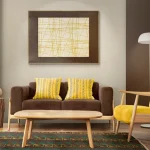Designing your dream home can be one of the most exciting yet challenging projects you’ll undertake. It’s not just about arranging furniture or picking paint colors; it’s about creating a space that reflects who you are and supports the way you live. Whether you’re starting from scratch or revamping your current living space, this beginner’s guide will help you navigate the journey of interior architecture with confidence and creativity.
Understanding Interior Architecture
Interior architecture merges the art of interior design with the science of architecture. It’s about shaping the interior space through structural changes while ensuring the design is aesthetically pleasing and functional. As Tobi Fairley, a renowned interior designer, says, “Designing your dream home is about more than just aesthetics. It’s about creating a space that reflects your personality and supports your lifestyle”.
Begin with a Vision
Start with a clear vision of what you want your dream home to look and feel like. Consider how you want each room to function. Are you an avid cook who needs a gourmet kitchen? Do you work from home and need a comfortable, inspiring office space? Create a list of must-haves and nice-to-haves.
My own experience taught me the importance of this step. When we first moved into our new house, I was overwhelmed with possibilities. My husband and I sat down and created a vision board, filled with clippings from magazines, paint swatches, and photos of furniture we loved. This visual guide kept us focused and ensured our home felt cohesive and personalized.
Space Planning
Effective space planning is crucial in interior architecture. Start by measuring your rooms and sketching a floor plan. Consider the flow of the space and how each area connects. Think about where the natural light enters and how you can maximize it.
“Functionality is key in interior design. Every element in your home should serve a purpose,” advises Michelle Nussbaumer, a respected architect. For example, if you have a small living room, opt for multi-functional furniture like a sofa bed or an ottoman with storage.
The Power of Color
Colors have a profound impact on our emotions and moods. The Psychology of Color in Interior Design study by the University of Sussex highlights how different hues can influence our well-being. For instance, blue can create a calming atmosphere, while yellow can energize a room.
When choosing a color palette, consider the mood you want to evoke in each space. In our home, we chose soothing greens and blues for the bedroom to promote relaxation, and vibrant yellows and oranges in the kitchen to create an uplifting environment for cooking and gatherings.
Incorporating Nature
Biophilic design, which integrates natural elements into interiors, has been shown to improve well-being and happiness. According to a study by Texas A&M University, using natural materials and incorporating plants can make your home feel more connected to the outdoors.
We added a variety of indoor plants to our living room and used natural wood finishes for our furniture. The difference was remarkable – the space felt more alive and inviting.
Embracing Personal Style
Your home should be a reflection of you. Kelly Wearstler, an influential interior designer, encourages homeowners to “experiment and take risks”. Don’t be afraid to mix different styles or incorporate unique pieces that tell your story.
Justina Blakeney, another expert in the field, emphasizes that “the best design is personal design”. When designing our dining room, we included a vintage table that had been in my family for generations. This piece not only added character but also connected us to our family’s history.
Lighting Matters
Lighting is one of the most critical aspects of interior design. It can transform a space by setting the mood, creating ambiance, and highlighting architectural features. Darren Bradley, a lighting designer, states, “Lighting is one of the most important aspects of interior design. It can set the mood, create ambiance, and highlight architectural features”.
Consider a mix of lighting sources, including ambient, task, and accent lighting. In our home office, we installed a combination of desk lamps for focused work and soft ambient lighting to create a cozy atmosphere during late-night brainstorming sessions.
Comfort and Functionality
While aesthetics are important, comfort and functionality should never be compromised. “Comfort is essential in a dream home. Choose furniture and finishes that are both stylish and inviting,” suggests Nate Berkus, a well-known interior designer.
When selecting furniture, sit on it, lie on it, and imagine using it daily. For instance, we chose a deep, plush sofa for our living room that was perfect for lounging with family and friends.
Staying Current with Trends
The Influence of Social Media on Interior Design Trends study by Stanford University shows how platforms like Pinterest and Instagram shape design aesthetics. While it’s great to be inspired by trends, make sure your choices are timeless and reflect your unique taste.
In our home, we blended modern trends with classic elements. We followed the popular trend of open shelving in the kitchen but chose timeless marble countertops and stainless steel appliances that would not go out of style.
Long-Term Satisfaction
Designing a home that brings long-term satisfaction requires thoughtful planning and consideration of future needs. The study by MIT and the University of California, Berkeley, on Long-Term User Satisfaction in Self-Designed Homes emphasizes the importance of flexibility and foresight in design.
Think about how your needs might change over time. When we designed our home, we included a multipurpose room that could serve as a guest room, home office, or playroom, depending on our needs in the future.
Conclusion
Designing your dream home is a journey of self-expression and creativity. By starting with a clear vision, focusing on functionality and comfort, and incorporating personal touches, you can create a space that not only looks beautiful but also enhances your quality of life. Remember the advice of experts like Tobi Fairley, Kelly Wearstler, and Michelle Nussbaumer, and don’t be afraid to take risks and experiment.
Your dream home should be a unique reflection of you, filled with elements that tell your story and support your lifestyle. So, roll up your sleeves, gather your inspiration, and start designing a space where you’ll love to live for years to come.









